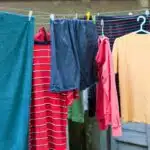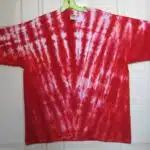As a laundry expert, I have seen many ways that people hang clothes on a clothesline. While it may seem like a simple task, there are certain techniques and practices that can make the process more efficient and effective. Whether you are looking to save money on your electricity bill or simply enjoy the fresh scent of air-dried clothing, learning how to properly hang clothes on a clothesline is an essential skill for any household.
One of the main benefits of using a clothesline is that it is environmentally friendly. By avoiding the use of a dryer, you can reduce your home’s carbon footprint and save energy costs. Additionally, hanging clothes on a line can help preserve the fabric and extend their lifespan. However, there are certain factors to consider when hanging clothes outside such as weather conditions, sunlight exposure and wind patterns. In this article, we will discuss best practices for hanging clothes on a clothesline in order to achieve optimal results in terms of drying time, freshness and wrinkle-free garments.
Choosing The Right Clothesline
When it comes to drying clothes, nothing beats the traditional method of hanging them on a clothesline. Not only is it eco-friendly and cost-effective, but it also gives your clothes a fresh outdoor scent. However, choosing the right clothesline can be a daunting task as there are various types available in the market.
The first thing to consider is whether you want an indoor or outdoor clothesline. Outdoor drying is ideal for sunny and windy weather conditions as it dries your clothes quickly and eliminates any odor-causing bacteria. On the other hand, indoor drying is perfect for colder climates or when you have limited space outside. It protects your clothes from harsh weather conditions while ensuring they dry at a slower pace.
Once you’ve decided on the type of drying that suits your needs, the next step is to choose the right clothesline according to your preferences. There are two main types of clotheslines – rotary and retractable. Rotary lines are perfect for those who have ample outdoor space as they allow you to hang multiple loads at once. Retractable lines, on the other hand, are suitable for smaller spaces as they can be mounted on walls or poles and retracted when not in use.
Before preparing your clothes for hanging, make sure you choose a clothesline that fits your needs best by weighing its pros and cons carefully.
Preparing Your Clothes For Hanging
Before hanging your clothes on a clothesline, it is important to prepare them properly. This involves taking steps to ensure that the clothes are clean and wrinkle-free. The following tips will help you prepare your clothes for hanging on a clothesline.
Firstly, make sure that any stains or spots on the clothing are removed before hanging them up. This can be achieved by using stain removal techniques such as pre-treating with a stain remover or soaking in a solution of water and detergent. For tougher stains, it may be necessary to use specialized products or seek professional cleaning services.
Secondly, ironing your clothes before hanging them can help prevent wrinkles and creases from forming while they dry. Ironing tips include using the appropriate heat setting for the fabric type, pressing down firmly but not too hard, and using a spray bottle filled with water to moisten stubborn wrinkles.
Lastly, consider sorting your clothes by material before hanging them up. This helps ensure that each item receives proper care and attention during the drying process. For example, delicate fabrics such as silk should be hung separately from heavier items like jeans to prevent stretching or damage.
- Use stain removal techniques such as pre-treatment or soaking in detergent solution.
- Iron clothing before hanging using appropriate heat settings and techniques.
- Sort clothing by material for better care during drying process.
- Seek professional cleaning services for tougher stains or delicate fabrics.
By following these preparation steps, you can ensure that your clothes are clean, wrinkle-free, and cared for properly while they dry on the clothesline. Next step is to sort your clothes by material for optimal results.
Sorting Clothes By Material
After carefully preparing your clothes for hanging, it’s time to move on to the next step: sorting your clothes by material. This is a crucial step in ensuring that your clothes are hung correctly and maintain their quality. Sorting clothes by color is also an essential part of this process to avoid any unwanted dye transfer.
When sorting clothes by material, it’s important to group similar fabrics together. Delicate fabrics such as silk or lace should be hung separately from heavier materials like denim or towels. This will prevent any potential damage to these delicate items and ensure they dry properly without stretching or losing their shape.
Hanging delicate fabrics can be a bit tricky, but with proper care and attention, you can do it flawlessly. It’s best to use hangers or lay them flat on the drying rack if possible. If you must use a clothesline, make sure not to stretch the fabric too much and avoid using too many clothespins in one spot. This will help prevent any unwanted creases or marks on the fabric.
Transitioning into the next section about using clothespins effectively, it’s important to note that they can be a valuable tool when hanging clothes on a line. However, it’s essential not to overuse them and distribute them evenly throughout the garment to avoid leaving any creases or marks behind.
Using Clothespins Effectively
When it comes to hanging clothes on a clothesline, using clothespins effectively is crucial. The first thing to consider is the type of clothespin you are using. Wooden and plastic clothespins are the most common types, but there are also magnetic and stainless-steel options available. Each type has its advantages and disadvantages, so it’s important to choose the right one for your needs.
Once you have selected the appropriate clothespin, it’s time to get creative. Clothespins can be used for more than just hanging clothes on a line. In fact, there are many creative clothespin crafts that you can make with them. For example, you can use them to make photo holders or even bookmarks. This not only adds a personal touch to your laundry routine but also helps reduce waste by repurposing old materials.
If you prefer not to use a clothesline or don’t have access to one, there are alternative drying methods that can be just as effective. One option is using an indoor drying rack, which allows your clothing to air dry without taking up too much space. Another option is using a dryer with low heat or air-dry settings to save energy and reduce damage to your clothing over time.
In the next section about hanging shirts and blouses, we will explore specific techniques for properly hanging these items on a clothesline or other drying methods. By following these techniques and utilizing creative ideas with your clothespins, you can make your laundry routine more efficient and enjoyable while reducing waste in the process.
Hanging Shirts And Blouses
After learning how to use clothespins effectively, it’s time to tackle the task of hanging shirts and blouses on a clothesline. Did you know that according to the Environmental Protection Agency (EPA), using a clothesline instead of a dryer can save up to 700 pounds of carbon dioxide emissions per year? This means that by hanging your clothes outside, you’re not only saving money on electricity bills but also making a positive impact on the environment.
When hanging shirts and blouses, it’s important to pay attention to collar tips and sleeve lengths. To keep collars from curling or folding inwards, hang them with the collar portion facing towards you and secure both ends with two separate pins. As for sleeve lengths, make sure each side is pinned at the same height to prevent uneven drying. Additionally, avoid overcrowding the line as this can cause wrinkling and prolong the drying process.
By hanging your shirts and blouses on a clothesline, you’re already taking steps towards wrinkle prevention. However, if you notice any small creases or wrinkles after drying, there are simple ways to iron them out without damaging your clothing. First, dampen the wrinkled area with water using a spray bottle or wet cloth. Then use an iron set at low heat and gently press down on the fabric until smooth. Remember to always check care labels before ironing as some fabrics may require different temperature settings.
Transition: Now that we’ve covered how to hang shirts and blouses effectively while preventing wrinkles, let’s move on to discussing best practices for hanging pants and shorts on a clothesline.
Hanging Pants And Shorts
Folding pants and shorts for clothesline drying is an important step to ensure proper air circulation and minimize wrinkles. Clothespins should be placed at the top of the garments and at the hem to ensure the clothing hangs evenly. When hanging pants and shorts, it is important to take the length into account; the longer they are, the higher the clips should be placed to avoid any dragging on the ground. Pants and shorts should also be hung with extra clips in the middle to keep them from creasing. Clothesline drying is an efficient and cost effective way to reduce wrinkles and save energy. Proper folding and clothespin placement will help maximize the effectiveness of clothesline drying.
Folding
When it comes to hanging pants and shorts on a clothesline, folding is an important step to ensure that the clothes dry properly and look neat. Different folding techniques can be used depending on the type of garment and personal preference. For pants, one common method is to fold them in half lengthwise and then fold again at the knees or cuffs. This creates a smaller size that fits easily on the line and also prevents any creases from forming in the middle.
Another important aspect of folding clothes for hanging is to save space. Shorts can take up a lot of room on the line if they are not folded efficiently. One technique is to fold them in half lengthwise and then in thirds horizontally. This creates a compact shape that can be hung by the waistband or hem without taking up too much space. It also helps prevent wrinkles and allows for more clothes to be hung on the line at once.
In conclusion, mastering different folding techniques for hanging pants and shorts can greatly improve the efficiency and appearance of your laundry routine. By folding clothes to save space, you can maximize your use of the clothesline while ensuring that each garment dries properly without any unsightly wrinkles or creases. With these tips in mind, you can enjoy fresh, clean clothes that are ready to wear straight off the line!
Clothespins
Hanging pants and shorts on a clothesline involves more than just clipping them up and leaving them to dry. It is important to consider different factors such as folding techniques, space-saving strategies, and the type of materials used in the process. When it comes to hanging clothes, one tool that is often overlooked but can make a big difference is the humble clothespin.
Clothespins are not just functional but also decorative. Decorating clothespins with paint, washi tape, or other embellishments can add a personal touch to your laundry routine while also making them easier to identify. This can be especially useful if you share a clothesline with others or want to differentiate between different types of clothing.
While traditional wooden clothespins are still popular, there are alternative materials available that can provide additional benefits. Plastic clips are lightweight and durable, making them ideal for outdoor use. Stainless steel clips are rust-resistant and can withstand harsh weather conditions. Choosing the right clothespin for your needs can enhance your laundry experience and ensure that your pants and shorts dry properly without any issues.
By incorporating decorating clothespins and considering alternative materials, you can elevate your laundry game while ensuring that your pants and shorts dry efficiently on the line. Whether you prefer minimalistic designs or vibrant colors, there is a clothespin out there for everyone. So next time you hang up your laundry, don’t forget about this small but mighty tool!
Lengths
When it comes to hanging pants and shorts on a clothesline, one important aspect that should not be overlooked is the length of the line. Measuring distances and adjusting heights can make a big difference in how effectively your laundry dries. As a laundry expert, I recommend using a tape measure to determine the distance between the posts or trees where you will be hanging your clothesline. This will ensure that your line is straight and level, allowing for even drying of all garments.
In addition to measuring distances, it is also important to consider the length of the line itself. If your line is too short, you may not have enough space to hang all of your pants and shorts without them overlapping or touching each other. On the other hand, if your line is too long, it may sag in the middle and cause your clothing to drag on the ground. Adjusting heights can help address these issues and create an optimal drying environment for all of your laundry.
When hanging pants and shorts on a clothesline, keep in mind that different types of garments may require different lengths of line. For example, longer items such as jeans or dresses may need more space than shorter items like shorts or underwear. By taking these factors into account and adjusting heights accordingly, you can ensure that each piece of clothing dries properly without any damage or wrinkling. Remember that every laundry load is unique and requires careful consideration when it comes to hanging on a clothesline.
Hanging Undergarments And Socks
When it comes to hanging undergarments and socks on a clothesline, there are some important considerations to keep in mind. First and foremost, you’ll want to organize your laundry properly before hanging it up. This means separating your undergarments and socks from other items like shirts or pants, so that they can dry more quickly and evenly.
Once you’ve sorted your laundry, it’s time to start hanging. When hanging undergarments, it’s best to use clothespins or hangers to avoid stretching out the fabric. Be sure to hang each item by the waistband or straps rather than the seams or edges, which can cause distortion over time. For socks, use clothespins or a sock clip designed for this purpose. This will help ensure that each sock dries completely and stays paired up.
Finally, be aware that undergarments and socks may dry more quickly than other items like towels or linens. Depending on the climate in your area, you may need to check them periodically throughout the drying process to ensure they don’t become over-dried and stiff. Once they’re dry, remove them promptly from the clothesline and move on to organizing your drawer!
When it comes to saving time and energy on laundry day, proper organization is key. By separating your undergarments and socks from other items like towels or linens, you can reduce drying time and get everything back in its proper place more quickly. In the next section, we’ll explore how to hang towels and linens for optimal results.
Hanging Towels And Linens
After carefully hanging your undergarments and socks, it’s time to move on to the next set of laundry items: towels and linens. These items are generally larger and require a different approach for optimal drying. Proper folding techniques can also help in maximizing space on your clothesline.
When hanging towels, shake them out first to fluff up the fibers and prevent stiffness when they dry. Then, fold them in half lengthwise before draping them over the line. If you have large beach towels, fold them into thirds instead for easier handling. For linens such as bed sheets and tablecloths, fold them in half or thirds depending on their size before hanging them by their corners.
One thing to keep in mind when drying towels and linens is that they may take longer than smaller items like undergarments and socks. Drying time expectations vary depending on factors such as humidity levels and wind speed. It’s important to check regularly to see if the items are fully dry before taking them off the line. This not only ensures maximum freshness but also helps extend the lifespan of your linens.
To avoid overcrowding your clothesline, consider staggering the placement of your items or using additional lines if available. This allows for proper air circulation which is crucial for efficient drying. By following these tips for towel and linen drying, you’ll be able to make the most out of your clothesline while keeping your laundry fresh and clean every time!
Avoiding Overcrowding Your Clothesline
As you prepare to hang your clothes on the clothesline, it’s important to consider how you organize the space available and properly space out your garments. Overcrowding the clothesline can cause problems such as tangled clothes, difficulty in access, and more importantly, prevent proper air circulation. Additionally, overcrowding may lead to weight distribution issues that can cause sagging or even breakage of the line.
One way to avoid overcrowding your clothesline is by organizing your garments into categories before hanging them. For instance, separate towels from undergarments and shirts from pants. This will enable you to plan better for spacing and weight distribution on the line. When hanging heavier items such as jeans or blankets, it’s advisable to place them at the ends of the line where there is more support.
Proper spacing involves leaving enough room between items on the line for air circulation and drying efficiency. A rule of thumb is to leave at least 6 inches between each item on the line. To help you visualize this, here’s a table showing recommended spacing for different types of clothing:
| Type of Clothing | Recommended Spacing |
|---|---|
| Shirts/Blouses | 4-6 inches |
| Pants/Jeans | 6-8 inches |
| Towels | 2-4 inches |
| Sheets | 8-10 inches |
By adhering to these guidelines for organizing space and proper spacing, you’ll ensure that your clothes dry faster and are not damaged during drying. In our next section, we’ll discuss how to deal with weather conditions when using a clothesline.
Dealing With Weather Conditions
Protecting clothes is a crucial aspect of hanging them on a clothesline. However, dealing with unexpected weather changes can be challenging. When the weather is unpredictable, it is essential to have a backup plan to protect your clothes from damage.
One way to protect your clothes during unexpected weather changes is by using clothing pins that are designed for windy conditions. These pins have wider jaws that hold the clothes tightly on the line, preventing them from falling off and getting damaged. Additionally, you can also use plastic or wooden pegs instead of metal ones as they are less likely to rust and stain your clothes.
Another effective way of protecting your clothes during adverse weather conditions is by using a protective cover or canopy over the clothesline. This cover acts as a shield against rain, wind, and other harsh elements that can damage your clothing. If you do not have a cover or canopy, you can use an umbrella to protect the clothes from raindrops.
In conclusion, protecting your clothes while hanging them on the line should be a top priority. Dealing with unexpected weather changes requires careful planning and preparation to avoid any damage or loss of clothing items. By using sturdy clothing pins designed for windy conditions, opting for plastic or wooden pegs instead of metal ones and utilizing protective covers or canopies over the line, you can ensure that your clothes remain safe and in good condition. In the next section, we will discuss ways of maximizing sunlight exposure when drying your laundry.
Maximizing Sunlight Exposure
- Selecting the right spot for a clothesline is essential for optimizing the amount of sunlight exposure that clothing receives.
- Optimizing clothes placement on the line requires considering wind patterns, shade and other elements that can affect the drying process.
- Clothes should be hung on hangers and not laid directly on the line to ensure that the clothing receives sunlight on both sides.
- Clothes should be spaced evenly on the line to allow for adequate air circulation.
- Choosing the best time of day to hang clothes on the line is an important factor in maximizing sunlight exposure.
- The best times to hang clothes are in the early morning and late afternoon when the sun is strongest and the air is cooler.
Selecting The Right Spot
As a laundry expert, it is essential to know how to select the right spot for hanging clothes on a clothesline. Finding the perfect location can make all the difference in maximizing sunlight exposure and achieving optimal drying results. It is crucial to choose an area that receives plenty of direct sunlight throughout the day, as this will speed up the drying process and leave your clothes smelling fresh and clean.
However, it is also important to consider other factors when selecting a spot for your clothesline. For instance, you should avoid areas that are too exposed to wind or prone to sudden gusts, as this can cause your clothes to fall off or fly away. Additionally, finding shade can be beneficial in preventing your clothes from fading due to prolonged sun exposure.
Dealing with uneven ground can also be a challenge when setting up a clothesline. You want to ensure that your line is level and taut so that your clothes dry evenly without sagging or becoming stretched out. If you have a sloping lawn or uneven terrain, it may be necessary to use stakes or poles to create a more stable foundation for your line.
In conclusion, selecting the right spot for hanging clothes on a clothesline requires careful consideration of various factors such as sunlight exposure, wind protection, shade availability, and ground stability. By taking these factors into account and making informed decisions about where to place your line, you can achieve optimal drying results and keep your laundry looking its best for years to come.
Optimizing Clothes Placement
After considering the importance of selecting the right spot for hanging clothes on a clothesline, it is now time to discuss another crucial aspect of optimizing drying results – spacing clothes and color coordination. Properly spacing your clothes on the line can help ensure that each item dries evenly and efficiently. It is essential to leave enough space between articles of clothing to allow air to circulate freely and prevent them from touching or overlapping.
Moreover, color coordination can also play a significant role in optimizing clothes placement. Grouping similar colors together can help prevent bleeding or fading, especially for darker or more vibrant hues. Lighter items such as whites and pastels should be placed towards the inside of the line, while darker items like blues and blacks should be hung towards the outside.
In summary, maximizing sunlight exposure is just one aspect of achieving optimal drying results when using a clothesline. Spacing clothes properly and coordinating colors are equally important considerations that must not be overlooked. By paying attention to these factors, you can ensure that your laundry dries evenly and maintains its vibrant color for longer periods, ultimately resulting in fresher-looking garments that last longer.
Choosing The Best Time Of Day
Air drying laundry is a cost-effective and eco-friendly alternative to using a dryer. Not only does it save energy, but it also helps preserve the quality of your clothes. One crucial aspect of air drying is maximizing sunlight exposure, which can shorten drying time and disinfect clothes. However, selecting the right time of day to hang your laundry can make a significant difference in achieving optimal results.
Choosing the best time of day for air drying is important for several reasons. First, checking the weather forecast can help you avoid hanging clothes during rain or high humidity, which can prolong drying time and even cause mold growth. Second, choosing a time when there’s ample sunlight can help speed up the drying process and prevent musty odors caused by dampness. Finally, hanging clothes during off-peak hours when the sun’s intensity is not at its peak can also help preserve colors and prevent fading.
To maximize sunlight exposure when air drying laundry, it’s best to hang clothes outside early in the morning or late in the afternoon when the sun’s rays are less intense. During these times, you can take advantage of gentle breezes to help promote better airflow and prevent clothes from clumping together. It’s also advisable to place white or lighter-colored clothes on lines facing eastward to catch morning sun while darker-colored garments should be hung on lines facing westward to get afternoon sun. By following these tips, you’ll achieve optimal results that will leave your clothes looking fresher and cleaner than ever before!
Preventing Clothes From Flying Away
After maximizing sunlight exposure for your clothes, it’s time to hang them on the clothesline. One of the essential things to consider when hanging clothes is tying knots that will secure them in place. It’s crucial to tie knots that won’t come undone easily, especially during windy weather.
Moreover, adjusting tension is also significant in keeping clothes from sagging or getting stretched out. The clothesline should be tight enough not to dip in the middle but not so tight that it strains the fabric. Adjusting tension may take some trial and error, but with practice, it can be done quickly.
Lastly, preventing clothes from flying away is an important consideration when hanging laundry outside. If you live in a windy area or have a lot of gusts coming through your yard, it’s best to use clothespins instead of relying solely on knots. Clothespins provide an extra layer of protection against wind and ensure that your laundry remains securely fastened until they’re dry.
Moving on to checking for dryness, one crucial indicator is the texture of your clothing. Wet fabric feels cold and heavy to the touch while dry fabric feels lighter and warm. Additionally, you can check if there are any damp spots left by pressing a portion of the garment against your cheek or lips. If there are still damp areas present, hang them back up and continue drying until they’re completely dry.
Checking For Dryness
Once you have hung your clothes on the clothesline, it’s important to check for dryness before taking them down. The amount of time it takes for clothes to dry can vary depending on the weather conditions and how much moisture is in the air. One way to tell if your clothes are dry is by feeling them. If they feel cool or damp, they are not dry yet.
Checking for wrinkles is also important when drying clothes on a clothesline. Clothes that have been left hanging for too long can become wrinkled and difficult to iron. To prevent this from happening, remove each item from the line as soon as it’s dry and fold or hang it immediately. This will help keep your clothes looking their best and save you time when it comes to ironing.
Preventing mildew is another concern when drying clothes outdoors. Mildew thrives in warm and humid environments, so make sure you don’t leave your wet laundry out overnight or during rainy weather. If you do notice any signs of mildew, such as a musty smell or black spots on your clothes, wash them again with a mildew remover before hanging them out to dry.
Nested bullet point list:
- Always check for dryness before taking down your clothes
- Feeling cool or damp indicates that the clothes are not yet dry
- Remove each item from the line as soon as it’s dry
- This prevents wrinkles from forming
- Avoid leaving wet laundry out overnight or during rainy weather
- This helps prevent mildew from forming
Transition sentence: Once your clothes are fully dried, the next step is to properly fold and store them to keep them looking their best.
Folding And Storing Clothes After Drying
Like a puzzle, folding and storing clothes after drying can be a satisfying challenge. Once you have your clean clothes in hand, it is essential to organize drawers before beginning the folding process. Start by sorting clothes and grouping them by category such as pants, shirts, or undergarments. This will make finding specific items easier when getting dressed.
When it comes to folding techniques, there are several options available depending on personal preferences. One popular method is the KonMari method, which involves neatly folding each garment into a small rectangle and standing them upright in drawers. Another technique is the traditional fold and stack approach, where clothes are folded in half or thirds and stacked on top of one another in an organized manner.
Regardless of the technique chosen, take care when folding delicate fabrics like silk or cashmere. These materials should be laid flat and folded gently to prevent damage. Once all clothes are neatly folded, place them back in their designated drawers with larger items at the bottom.
Next up: troubleshooting common issues that may arise during the laundry process. From unexpected stains to shrinking fabrics, we’ll cover tips and tricks for addressing these common problems seamlessly.
Troubleshooting Common Issues
Sometimes, even when you think you have mastered the art of hanging clothes on a clothesline, problems can arise. These issues can range from clothes getting tangled to the line sagging under the weight of wet garments. Here are some common issues that may arise and how to address them.
Adjusting tension: One common issue is that the clothesline may become too loose or too tight. If it is too loose, the line will sag and cause your clothes to touch the ground. On the other hand, if it’s too tight, it can cause damage to both your clothes and the line itself. To adjust tension, first, determine what type of line you have (e.g., elastic or non-elastic) and then make small adjustments by tightening or loosening your anchor points until you reach an optimal tension.
Preventing tangling: Another problem that can occur is when clothes tangle together while drying. This often happens when clothes are placed too close together or if there is a lot of wind. To prevent tangling, try spacing your clothing out more on the line and using clips instead of trying to overlap items on top of each other. Another tip would be to keep heavier items like towels or jeans separate from lighter ones like t-shirts or dresses.
Maintaining proper care for your clothesline and avoiding these common issues will go a long way in extending its lifespan. Remember to adjust tension as needed and avoid overcrowding items on the line to prevent tangling from occurring. By following these simple tips, you’ll be able to enjoy fresh smelling laundry in no time!
Conclusion
Hanging clothes on a clothesline is not only an environmentally-friendly option but also allows for a natural and fresh scent. Choosing the right clothesline and preparing your clothes properly are crucial steps in ensuring that your clothes dry efficiently. Sorting clothes by material and using clothespins effectively can prevent damage to delicate fabrics.
When hanging shirts and blouses, it’s important to consider the collar and shoulders to avoid stretching or misshaping. Preventing clothes from flying away can be achieved by using hangers or weighing down heavier items with clips. Checking for dryness ensures that your clothes are ready for folding and storing after drying.
According to research conducted by the Environmental Protection Agency (EPA), if every household in the United States replaced just one load of machine-dried laundry per week with line-drying, we could save 1.3 billion pounds of carbon dioxide emissions annually. As a laundry expert, I encourage individuals to consider line-drying as a simple yet impactful way to reduce their carbon footprint while keeping their clothes fresh and clean. By following these tips for hanging clothes on a clothesline, you can ensure that your laundry day is efficient and effective.
Image Credits
- “Clothesline & Bikes” by Professor Bop (featured)












![How To Wash And Care For White Clothes 12 The only genuine borax soap cleanses hygienically saves the clothes and hands. 20 Mule-Team brand Boraxo white laundry soap [front]](https://green-life.blog/wp-content/uploads/2023/05/YDXLLCovnOjq-150x150.jpg.webp)
















